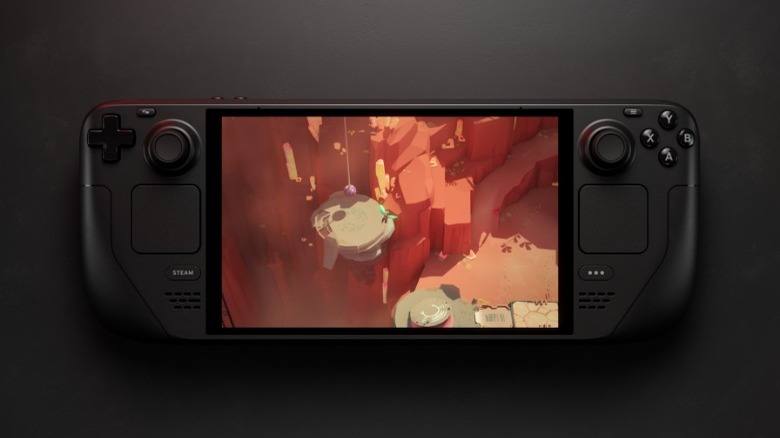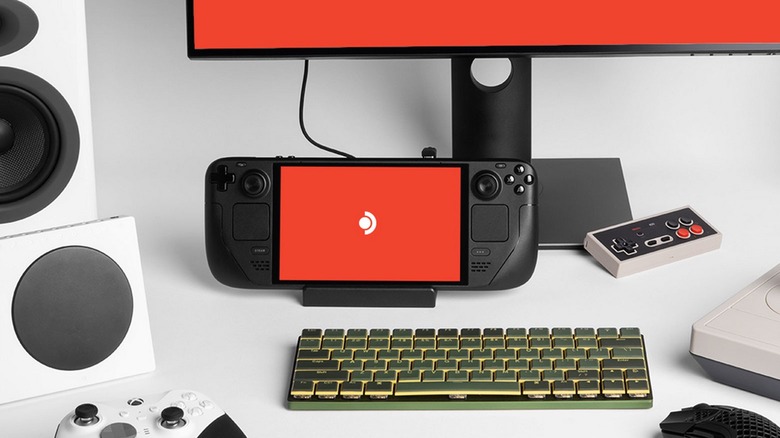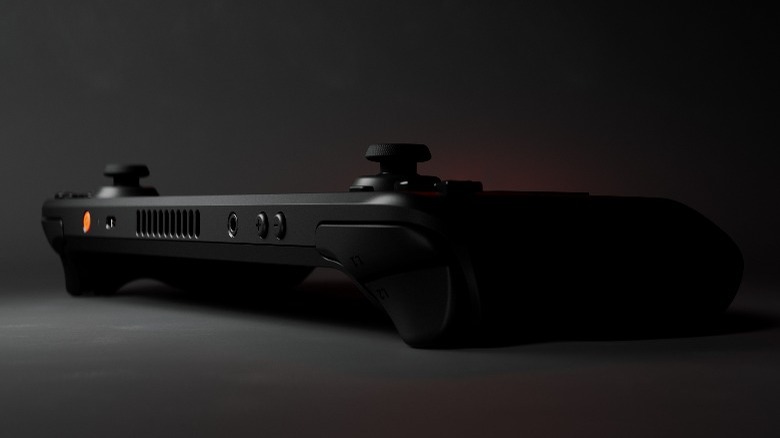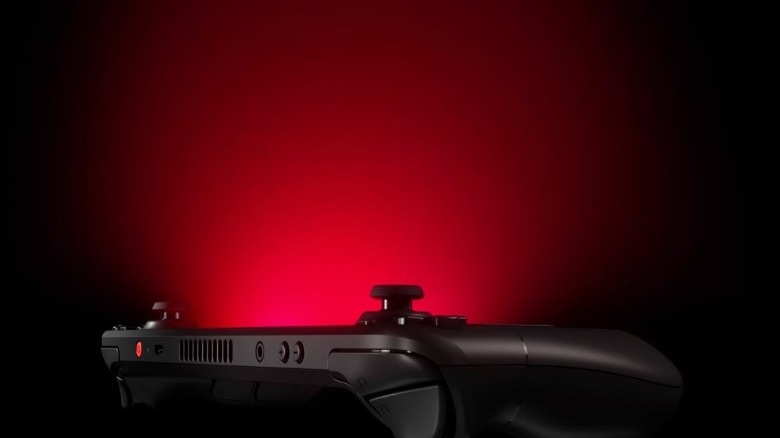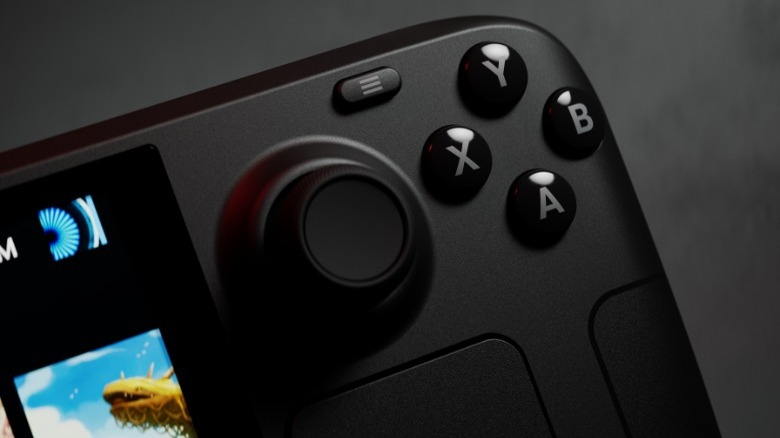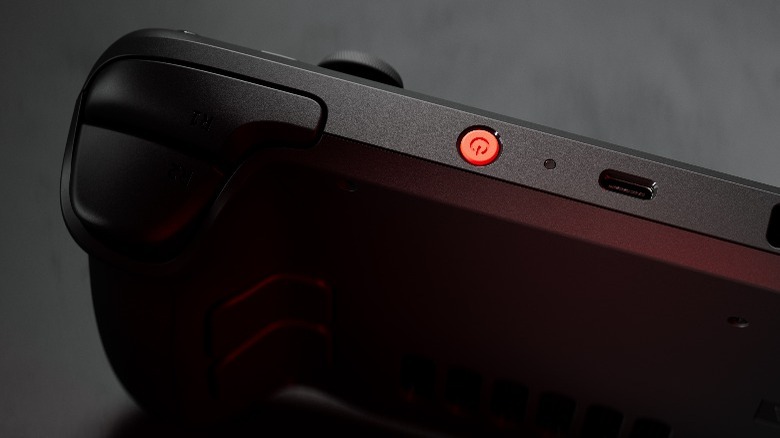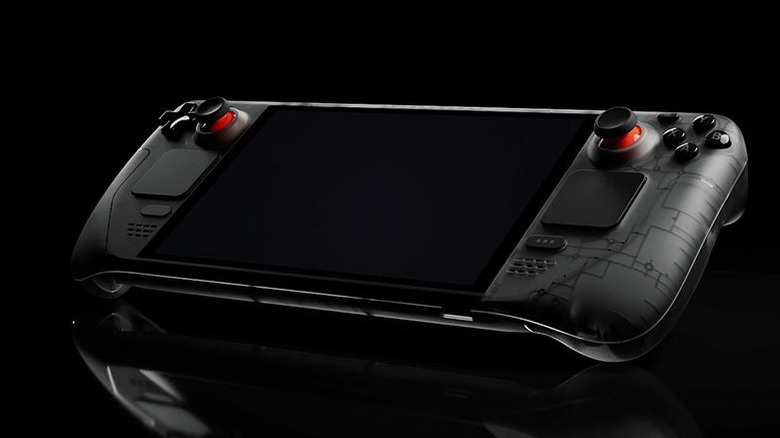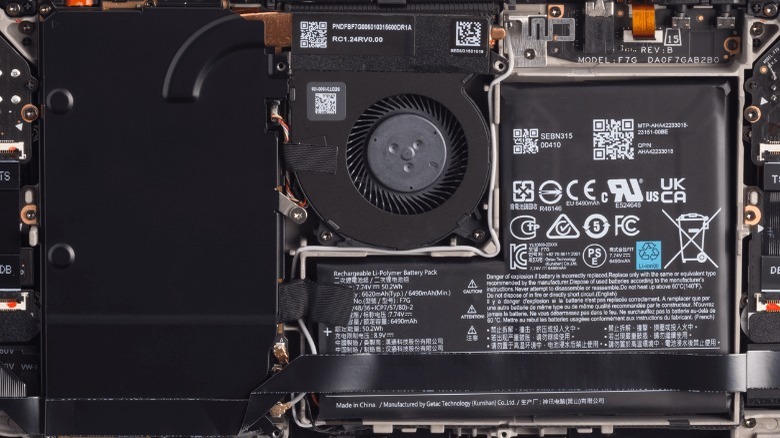Everything You Need To Know About The New OLED Steam Deck
Since its launch in 2022, Valve's Steam Deck has been met with plenty of praise and has exceeded expectations in terms of sales figures. While it couldn't be described as a runaway success, the device — which is akin to the Nintendo Switch but operates as a handheld gaming computer rather than a console — certainly has a lot of fans. Considering that Valve's last hardware project, Steam Machines, was a failure, it has been an astonishing turnaround.
That success always made it likely that the company would release new versions of the system at some point in the future, and users have already voiced their opinions about the upgrades and improvements it should have. Well, that time has now come with the recently released Steam Deck OLED.
Of course, as with any hardware revision, the question is whether it is worth buying. That applies to those who already own the original Steam Deck and people who have yet to take the plunge on the portable handheld computer. Here we will dive into everything you need to know about the new product so you can decide whether it's worth the investment.
A fresh OLED screen
The standout feature of the Steam Deck OLED is, of course, the organic light-emitting diode screen. This mirrors Nintendo's own revision of the Switch, with an OLED version arriving on October 8, 2021, some four years after the launch of the original console. Like the Nintendo Switch, this new Steam Deck isn't a proper successor; in fact, it is more like a premium option. Yet, the addition of the OLED screen addresses one of the most requested features for an upgraded Steam Deck and will make games look better than ever before when played in handheld mode.
The reason behind this is that OLED screens use self-illuminating LEDs rather than a backlight to light the entire display. This allows blacks to be shown as dark as they should be, giving a fantastic contrast between vivid colors and dark shades. OLED screens also offer a number of other advantages, including that they are usually much lighter than LCD screens and have wider viewing angles.
Valve promises that the Steam Deck OLED will show games with "more colors, pure blacks, and amazing motion rendition." The HDR technology will also allow for better contrast and clarity compared to the original Steam Deck, giving a striking new look to your games.
The screen is also bigger and brighter
The Steam Deck OLED has some other notable changes and upgrades for the display, outside of the technology used to light it up. While it does have exactly the same 1280 x 800 resolution as the original device, this new version has a larger, 7.4-inch screen. That makes it significantly larger than the 7-inch display for the 2022 model of the Steam Deck. It also features a higher refresh rate of 90Hz (rather than 60Hz) and a higher maximum brightness. The original device could reach a peak brightness of 400 nits, but the new version is more than twice as bright, able to produce 1,000 nits in HDR and 600 nits in SDR.
In promoting the Steam Deck OLED, Valve also claimed that the touchscreen is faster and more responsive. This has been backed up in reviews, with critics noting that it had far less latency than its predecessor. This is particularly useful not only for playing games but also for the on-screen keyboard and other user interface elements. The higher refresh rate allows for less input lag as well, with the responsiveness of the image being around 10ms faster on average.
Better battery life
A major issue with the Steam Deck is the system's battery life. Officially, Valve estimates the console should last anywhere from two to eight hours before a recharge is needed. Of course, that's dependent on the game you are playing and the settings the system is running at. More demanding sessions will drain the battery faster, and there are reports of the Steam Deck lasting less than two hours with particularly graphics-intensive games.
The restrictive battery life of the device is often highlighted as one of its biggest drawbacks, so the fact that the new model comes with an improvement in this area will be welcome news to many. According to Valve, players can expect between 30 and 50 percent longer battery life. That's due to a number of factors, like a bigger battery and a more efficient APU. The new OLED screen also draws less power, helping the battery last longer.
More storage
The original Steam Deck was available in three varieties when it launched. Users could go for the 64GB eMMC option, or decide on a larger internal storage solution with the two SSD models that boasted 256GB or 512GB of capacity. Even the largest of these, though, fall far short of what gamers need. After all, modern consoles feature significantly more storage capacity and games can routinely have install sizes that exceed 100GB or more. What's more, there aren't specific Steam Deck versions of games available on Steam that are smaller in size, meaning owners of the portable device need to install the full games to play them.
Thankfully, the Steam Deck OLED offers more choice when it comes to larger internal storage options — at least at the higher end of the range. Buyers can go with a 512GB NVMe SSD or the larger 1TB version, which puts the device on an even footing with the Xbox Series X. You'll have to fork out more money to get your hands on the upgraded systems as they are both pricier than the first-generation Steam Deck. Buyers will now need to spend $549 and $649 on an OLED model, depending on the size of the internal SSD they choose.
The original model is seeing price reductions
Unlike the recently announced PlayStation 5 revision, the Steam Deck OLED is not a direct replacement for the original device. While Sony intends to stop production of its original console with the launch of the new model, Valve will continue to sell the initial Steam Deck with its LCD screen — with one caveat. Only the 256GB variant of this device will remain in production. "The 64GB and 512GB Steam Deck LCD models are being phased out," reads the Steam Deck store page. "We have permanently discounted these models and they will be available until they are out of stock."
The 64GB model is now priced at $349.99 and the 512GB version is now discounted to $449.99. That's a saving of around $50 for both systems and means the base variant now costs the same as the Nintendo Switch. Meanwhile, the 256GB edition is also reduced and retails at $399.99.
While some of the original Steam Deck releases are being discontinued, that shouldn't put you off buying one. Valve confirmed to Polygon that updates and patches to both SteamOS and the digital storefront Steam will be released for both versions of the Steam Deck. The fact that Valve is continuing to produce the 256GB model means the company will still have everything it needs to produce spare parts and repair the 64GB and 512GB devices.
It's available right now
Almost as soon as the Steam Deck launched, people were calling for an OLED version, especially in the face of complaints that the screen had a washed-out look to it that didn't hold up to the displays on other handheld devices, such as the Nintendo Switch. With an initial release in February 2022, that means there have been calls for an upgraded screen for almost two years, amid many rumors.
Thankfully, when Valve did reveal the Steam Deck OLED, players didn't have another arduous wait until they could get their hands on the device. In fact, it is available to purchase right now in most markets. From the first announcement about the system on November 9, there was only a wait of a week before it was available to purchase on November 16. So if you fancy upgrading from your older Steam Deck or jumping in for the first time, you don't have to hang around to do so.
Most of the specs are unchanged
For those wanting a vastly superior handheld gaming computer, the new Steam Deck OLED might not be the option for you. That's because nothing has really changed under the hood of this system compared to its predecessor. In fact, players shouldn't expect a proper successor to the Steam Deck in the near future. Valve told GamesIndustryBiz that the company wants the Steam Deck 2 to "be a generational increase," and that the current technology would not allow for a meaningful power upgrade in a portable device.
Comparing the specs of both versions of the Steam Deck reveals only incremental improvements. Both devices have exactly the same GPU and CPU configurations, while the 16GB of 6400 MT/s LPDDR5 memory on the OLED model means it has slightly faster RAM compared to the older LCD version. Games will therefore run pretty much the same with just a few minor improvements, such as slightly faster load times and an extra few frames. Unless the OLED screen really interests you, Steam Deck owners will probably want to put off buying it right now.
It's lighter but keeps the same size and shape
Thanks to some redesign work and the fact that the OLED screen is significantly lighter than the previous model's LCD display, the more recent Steam Deck OLED is lighter than its predecessor. In total, Valve says that the OLED variant is 30g less heavy than the original launch, and that includes some additional thermal components to keep the system cooler than ever before. Despite all of this, the physical dimensions of the Steam Deck OLED are exactly the same.
Keeping the same profile and shape is important as it ensures that the Steam Deck OLED is compatible with all previous accessories. Previous owners of the original Steam Deck won't have to buy all new gear for the new system and customers won't have to worry about whether the Steam Deck peripheral they are buying will work with both models. Just make sure you avoid these Steam Deck accessories that are a complete waste of money.
Faster internet with Wi-Fi 6E support
Another notable addition to the Steam Deck OLED is support for Wi-Fi 6E. This means that the new product has access to 6Ghz operation and is future-proof for devices that utilize that faster wi-fi connection. According to Valve, this allows for "increased bandwidth and lower latency" which should lead to "faster downloads (up to 3 times faster!) and stable online play."
On the official Steam Deck OLED page, Valve also details the upgrades to its Bluetooth support. The device can now connect with other accessories that run on Bluetooth 5.3 and supports more recent codecs such as aptX HD and aptX low-latency. The company has also added a new third antenna that sits at the top of the device inside the case, which Valve claims will improve Bluetooth performance. Players will also be able to wake up the Steam Deck using a Bluetooth controller for the first time thanks to these updates.
A limited-edition model is available
As part of the launch of the new Steam Deck OLED, Valve has also launched a limited-edition version of the system. The device costs an additional $30 and is a variant of the 1TB model that is also available. The only noticeable difference is its new aesthetic, with the device having a translucent case that allows you to see some of the inner workings. This version of the Steam Deck OLED also comes with a carry case that features a unique design compared to the standard one.
The only issue is that those living outside the U.S. and Canada will not be able to pick up the limited-edition model. Valve is exclusively releasing it in those two regions, meaning players in the rest of the world will have to make do with the standard color options. There's another restriction as well, with users needing to have a Steam account in good standing that has made a purchase before November 2023. Even then, customers will only be able to buy a single Steam Deck OLED Limited Edition, to ensure that there is enough stock for everyone.
Valve says this special version of the device is an experiment to test whether there is demand for the unique design. Speaking on Twitter, the company confirmed, "If we see high demand it will give us confidence to do more colorways in the future."
There are some other quality-of-life improvements
A major improvement for the Steam Deck OLED is that Valve has streamlined the repair process. All of the screws within the device are Torx, so users don't have to constantly swap heads while taking apart the outer cover. Switches for various controller parts have also been moved onto one board to make them easier to access.
In addition to improving the Steam Deck, Valve has also made some updates to the zip-up carry case. Those who choose the 1 TB model of the Steam Deck OLED get a new hard case that features a smaller and slimmer case inside, so you don't have to carry the rather chunky case around with you all the time. The charging power cable for the device has been lengthened from 1.5 meters to 2.5 meters, so you have more freedom over where to place the docking station.
The Steam Deck has already been noted for its excellent audio, but that has also been slightly improved for the new OLED model. The bass response has been boosted to provide a flatter sound profile and means that the device is both louder and able to produce lower notes more effectively. Meanwhile, the new OLED screen doesn't just mean a reduction in weight. Thanks to the fact that it takes up less space than the LCD screen, Valve has been able to include a bigger fan that is more efficient. The end result is that it can is much quieter than its older counterpart.

